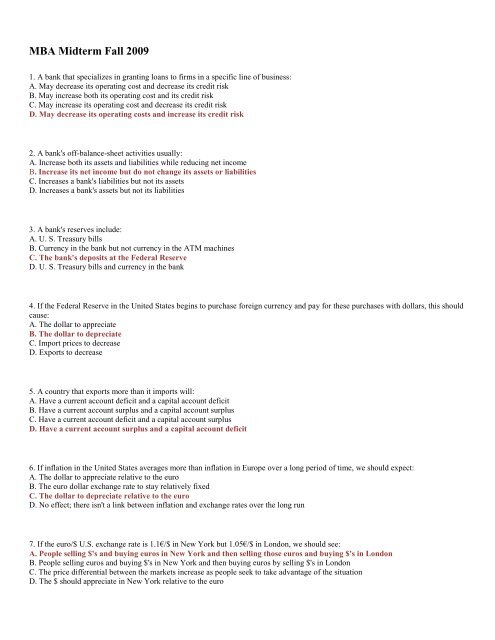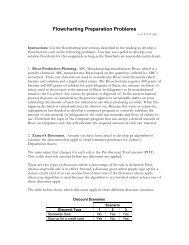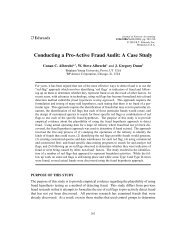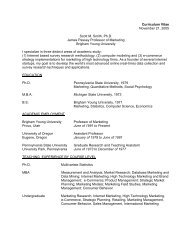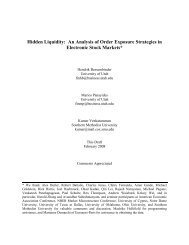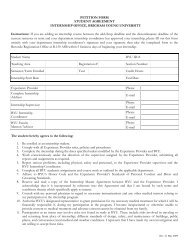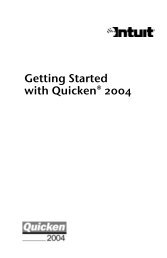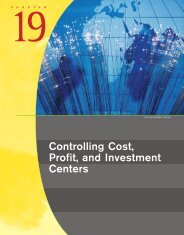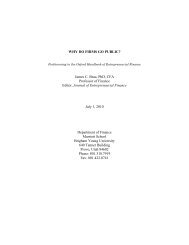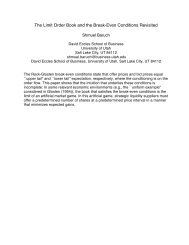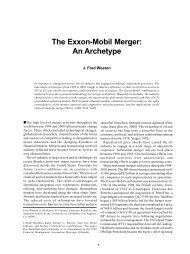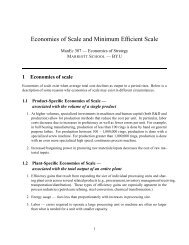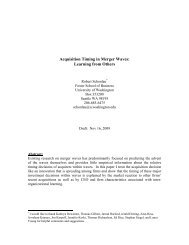Previous Midterm Key - Marriott School
Previous Midterm Key - Marriott School
Previous Midterm Key - Marriott School
Create successful ePaper yourself
Turn your PDF publications into a flip-book with our unique Google optimized e-Paper software.
MBA <strong>Midterm</strong> Fall 2009<br />
1. A bank that specializes in granting loans to firms in a specific line of business:<br />
A. May decrease its operating cost and decrease its credit risk<br />
B. May increase both its operating cost and its credit risk<br />
C. May increase its operating cost and decrease its credit risk<br />
D. May decrease its operating costs and increase its credit risk<br />
2. A bank's off-balance-sheet activities usually:<br />
A. Increase both its assets and liabilities while reducing net income<br />
B. Increase its net income but do not change its assets or liabilities<br />
C. Increases a bank's liabilities but not its assets<br />
D. Increases a bank's assets but not its liabilities<br />
3. A bank's reserves include:<br />
A. U. S. Treasury bills<br />
B. Currency in the bank but not currency in the ATM machines<br />
C. The bank's deposits at the Federal Reserve<br />
D. U. S. Treasury bills and currency in the bank<br />
4. If the Federal Reserve in the United States begins to purchase foreign currency and pay for these purchases with dollars, this should<br />
cause:<br />
A. The dollar to appreciate<br />
B. The dollar to depreciate<br />
C. Import prices to decrease<br />
D. Exports to decrease<br />
5. A country that exports more than it imports will:<br />
A. Have a current account deficit and a capital account deficit<br />
B. Have a current account surplus and a capital account surplus<br />
C. Have a current account deficit and a capital account surplus<br />
D. Have a current account surplus and a capital account deficit<br />
6. If inflation in the United States averages more than inflation in Europe over a long period of time, we should expect:<br />
A. The dollar to appreciate relative to the euro<br />
B. The euro dollar exchange rate to stay relatively fixed<br />
C. The dollar to depreciate relative to the euro<br />
D. No effect; there isn't a link between inflation and exchange rates over the long run<br />
7. If the euro/$ U.S. exchange rate is 1.1€/$ in New York but 1.05€/$ in London, we should see:<br />
A. People selling $'s and buying euros in New York and then selling those euros and buying $'s in London<br />
B. People selling euros and buying $'s in New York and then buying euros by selling $'s in London<br />
C. The price differential between the markets increase as people seek to take advantage of the situation<br />
D. The $ should appreciate in New York relative to the euro
8. If in late 2003 one U.S. dollar exchanged for 118 euros and in mid-2004 one U.S. dollar exchanged for 127 euros, then:<br />
A. The euro appreciated relative to the dollar<br />
B. The dollar appreciated relative to the euro<br />
C. European goods became more expensive to Americans<br />
D. American goods became more expensive to Americans<br />
9. Interest-rate risk would not matter to which of the following bondholders<br />
A. A holder of a U.S. government bond<br />
B. A holder of a U.S. government bond indexed for inflation<br />
C. A holder of a U.S. government bond who plans on selling it in one year<br />
D. A holder of a U.S. government bond that plans on holding it until it matures<br />
10. Suppose that the return on assets other than bonds falls. In the bond market this will result in:<br />
A. A movement down the bond demand curve<br />
B. A shift to the left of the bond demand curve<br />
C. An increase in the price of bonds<br />
D. A shift to the left of the bond supply curve<br />
11. If interest rates are expected to fall, bond prices will:<br />
A. Fall as the demand for bonds decreases<br />
B. Remain constant until interest rates actually change<br />
C. Fall as people fear capital losses in the future<br />
D. Increase due to the demand for bonds increasing<br />
12. When expected inflation increases, for any given nominal interest rate:<br />
A. The cost of borrowing increases and the desire to borrow decreases<br />
B. The real interest rate increases<br />
C. The bond supply curve shifts to the left<br />
D. The cost of borrowing decreases and the desire to borrow increases<br />
13. The bond demand curve slopes downward because:<br />
A. At lower prices the reward for holding the bond increases<br />
B. As bond prices fall so do yields<br />
C. As bond prices fall bonds are less attractive<br />
D. As bond prices rise yields increase<br />
14. A 30-year Treasury bond as a face value of $1,000, price of $1,200 with a $50 coupon payment. Assume the price of this bond<br />
decreases to $1,100 over the next year. The one-year holding period return is equal to:<br />
A. -9.17%<br />
B. -8.33%<br />
C. -4.17%<br />
D. -3.79%
15. Which of the following statements is incorrect<br />
A. If you can buy the same goods this year as you bought last year with less money there must have been deflation<br />
B. If you can buy the same goods this year as you purchased one year ago with the same amount of money, prices are stable<br />
C. If purchasing the same goods today that were purchased one year ago requires more money, there must have been inflation<br />
D. If you can buy the same goods this year as you bought last year with the same money there must have been deflation<br />
16. Which of the following statements is most correct<br />
A. Money is wealth but not all wealth is money<br />
B. Money is a means of payment but is not part of wealth<br />
C. In order to be considered part of a person's wealth, an asset must have a positive return<br />
D. Wealth is a store of value but is not a means of payment<br />
17. For every $100 in assets, a bank has $40 in interest-rate sensitive assets, and the other $60 in non-interest-rate sensitive assets. The<br />
same bank has $50 for every $100 in liabilities in interest-rate sensitive liabilities, the other $50 are in liabilities that are not interest-rate<br />
sensitive. If the interest rate on assets increases from 5 to 6 percent, and the interest rate on liabilities increases from 3 to 4, percent the<br />
impact on the bank's profits per $100 of assets will be:<br />
A. An increase of $0.10<br />
B. A decrease of $0.10<br />
C. A reduction of $1.00<br />
D. Zero since the interest rates on assets and liabilities increased by the same amount<br />
18. The problem for a central bank setting a zero inflation policy would be:<br />
A. The risk of high employment<br />
B. It is impossible to have zero inflation<br />
C. Firms would have to cut nominal wages to reduce labor cost<br />
D. Economic growth would also have to be zero<br />
19. The consequences of an economy operating below its potential level include:<br />
A. Higher unemployment, but there is no effect on the future standard of living<br />
B. High rates of inflation<br />
C. A lower standard of living in the future, but no effect on unemployment<br />
D. Higher unemployment and a lower standard of living in the future<br />
20. For fiscal policymakers, one of the results of an independent central bank is:<br />
A. To finance government spending the Treasury has to order more currency from the central bank<br />
B. Fiscal policymakers always have to borrow to increase spending<br />
C. Fiscal policymakers cannot borrow unless the Federal Reserve prints more money<br />
D. Increased government spending has to be financed with either higher taxes or increased government borrowing


